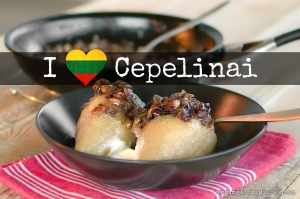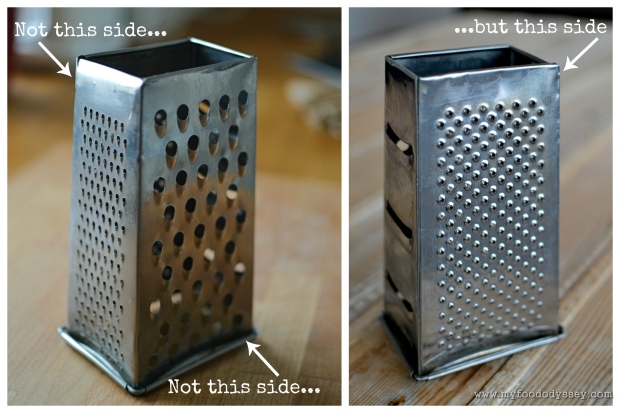Cepelinai for Beginners [Recipe]

The first time I made cepelinai I failed miserably. And the second time. And probably the third time. After that, I called it quits and resolved only to eat cepelinai that had been prepared for me by someone who knew what they were talking about – either at a restaurant or by one of our Lithuanian friends.
It’s not that cepelinai are particularly difficult to prepare, it’s just that the concepts were so foreign to me. I was told that they were made with grated potato, so I grated my potatoes the same way I would for hash browns. But that’s not what’s required. Although many recipes for cepelinai call for grated or even finely grated potato, what they actually mean is pulverized potato. If using a simple box grater you would use the zesting side, not the grating side.

The concept of making a potato dough using a combination of grated raw and cooked potato was also new to me. I thought we Irish ate a lot of potatoes, but our potato-eating habits pale by comparison with Lithuanians. Lithuanians have made potato-eating an art form, with a wide repertoire of dishes based largely around the humble spud.
To the uninitiated, cepelinai (pronounced sep-elle-in-ay) are dumplings made with potato dough and a meat, cheese or vegetable filling. They are the national dish of Lithuania, having been prepared here for over 150 years. Originally called “didžkukuliai” (which literally means “big meatballs”), they were rechristened cepelinai early in the 20th century due to their similarity in shape to the zeppelin airships.
Cepelinai are stodgy, hearty fodder designed to feed hungry workers at harvest time or to provide sustenance and warmth during the harsh Lithuanian winters. Calorie-wise, they pack a real punch. A single 200 g dumpling contains 385 g of potato*. This is because two-thirds of the weight of the grated potato is lost when you squeeze out the water. Add to this the fatty mince (ground pork) and the even fattier pork belly, plus a nice dollop of sour cream, and you can see how the calorie-conscious might shy away from them.
*Based on my recipe, using a ratio of 60% raw potato to 40% cooked potato.

Despite being the national dish, cepelinai are only prepared in Lithuanian homes on special occasions. They take quite a bit of time and are really only worth making in large batches. They are typically made as a treat for guests or, as mentioned, to feed hungry workers bringing potatoes or hay in from the fields.
Like all traditional dishes, every Lithuanian family has their own cepelinai recipe. If you have a tried and tested recipe that you love, far be it from me to tell you how to make them! This recipe is designed for those who might be new to making cepelinai. As such, I have tried to make it as foolproof as possible and have provided detailed instructions and photos on how to build your dumplings.


After an extensive search both online and in cookbooks I could find no consensus as to the correct proportion of raw to cooked potato for the dough. I know people who make them entirely from cooked potato (adding potato starch to stop them from falling apart) and others who make them almost entirely from raw potato. Having experimented for over a month I have settled on a 60/40 split. (60% or 750 g grated and strained raw potato to 40% or 500 g cooked and mashed potato.) This yields a dumpling that is sturdy enough to hold together during cooking but at the same time is soft and not too heavy to eat.
I don’t use either egg or onion in the meat mixture. It doesn’t need egg to bind it together. In fact, adding egg tends to make the cooked meatballs a little hard. Because the meat is cooked inside the dumpling, even the smallest pieces of onion don’t soften and cook in the time. There is plenty of onion flavour in the spirgučiai so there’s no need for any in the meat.
Cepelinai can come with a variety of sauces and toppings, but the most common is spirgučiai (pronounced spir-goo-chay), made with fried onion and bacon belly (side), and a generous dollop of sour cream. Lithuanian sour cream is very rich, typically being 30-40% fat. You could substitute crème fraîche, lower-fat sour cream or even Greek yoghurt if you prefer.

Lithuanian Cepelinai
INGREDIENTS:
For the potato dough:
3 kg | 6 lb 9 oz potatoes
2 tsp salt
Potato starch or cornflour, as required. (See method below.)
For the meat filling:
500 g | 1 lb 2 oz pork mince (ground pork)
1 tsp salt
½ tsp garlic powder
2 Tbsp cold water
For the topping:
250 g | 9 oz smoked bacon belly (side) or pancetta, finely diced
400 g | 14 oz onion (about 4-5 medium onions), finely chopped
To cook:
2 Tbsp potato starch or cornflour
100 ml | ½ cup cold water
To serve:
8 Tbsp sour cream / crème fraîche
METHOD:
- Peel the potatoes, placing the potatoes into a large bowl of cold water as they are peeled to ensure they do not turn brown.
- Take 500 g | 1 lbs 2 oz of potato, cut into quarters and place in a saucepan. Cover the potatoes with boiling water, place on a high heat and bring back to the boil, then reduce the heat to low, cover with a lid and simmer for 8-12 minutes until the tip of a knife can easily be inserted into the potato pieces. Drain and set aside, uncovered, to cool.
- While the potatoes are boiling grate or purée the remaining raw potato. If you’re not lucky enough to own a specialist potato grating machine, then use either the zesting side of a box grater or purée the potatoes to a very fine pulp in a food processor. If using a food processor you will need to process the potatoes in two batches to ensure there are no small lumps left in the purée.
- Pour the purée into a large piece of butter muslin or cheesecloth (I use a cotton pillowcase) set over a large bowl. Gather the corners of the material and twist to squeeze out all water from the potatoes. This can take 5-10 minutes depending on the variety of potato and the strength of your hands.
- When no further water can be squeezed from the grated potato, carefully transfer the dry grated potato to a large bowl. Keep the liquid that came out of the potatoes – you may need this later
- Using a potato ricer or masher, mash the cooked potatoes until no lumps remain. (Do not add any liquids or fats to the potato as you might if you were making mashed potato.) Add the mashed potato to the grated raw potato.
- Add the salt to the potato and mix well with your hands to fully incorporate the ingredients.
- The resultant dough should be roughly the consistency of play dough – it should form a smooth ball easily but should not stick to your hands. The consistency of the dough is key to the success of your final cepelinai. If it is too wet it will stick to your hands as you form your dumplings. If it is too dry it will crack as you form the dumplings and they may split or fall apart during cooking. If your mix is too dry add a little of the liquid from the grated potatoes, 1 tablespoon at a time, until it reaches the required consistency. If the mixture is too wet, add some potato starch or cornflour, 1 tablespoon at a time, until it reaches the required consistency.
- In a separate bowl, add the pork mince (ground pork), salt, garlic powder and water. Mix thoroughly using your hands.
- Divide both the potato dough and meat mixture into 8 equal portions and lay out on a plate or worktop ready for assembly. Form the meat into tight balls the shape of a rugby ball (American football).
- You are now ready to form your cepelinai. Take a portion of dough and flatten it against the palm of your hand until it is roughly the shape of your hand and just under 1 cm (½ inch) thick, turning regularly as you shape the dough to ensure it does not stick to your hands.
- Place a piece of meat on the centre of the dough, fold the sides of the dough over the top of the meat and pinch the dough together firmly to seal the join. Firmly press the dumpling between your two palms, rotating the dumpling little by little, to form the classic zeppelin shape.
- Ensure there are no cracks on the surface of the dumpling. If you find any cracks, dip your fingertip into the juice from the grated potatoes and gently smooth over the cracks to seal them.
- Continue with the remaining ingredients until you have assembled all your cepelinai.
- Half-fill a 7 litre / 7 quart saucepan, Dutch oven or other large saucepan with cold water and set over a high heat. When the water is boiling, mix 2 tablespoons of potato starch or cornflour with a cup of cold water and add to the saucepan, stirring well as you add the starch liquid to ensure it does not form a gelatinous ball. Adding starch to the cooking water helps to prevent the dumplings from splitting during cooking. It also helps to give the dumplings a smooth, glossy exterior.
- Carefully add the dumplings to the saucepan. (They will initially sink to the bottom, but will later float to the surface.) Cover the saucepan with a lid, bring the water back to the boil, then reduce the heat to very low so that the water is just barely simmering – if the water is boiling too hard the dumplings might split. Simmer for 45 minutes.
- While the cepelinai are cooking make the spirgučiai. Add the bacon pieces to a frying pan or saucepan and set over a high heat. There is no need to add any oil or fat as the fat will render from the bacon. When the bacon pieces are golden and starting to crisp, add the onion and reduce the heat to medium. Cook, stirring frequently, until the onions are soft and just starting to turn brown.
- To serve, carefully lift the cepelinai from the saucepan using a slotted spoon and place on a bowl or plate. Top with a spoon of spirgučiai and a dollop of sour cream.



NEW! Lithuanian Cookbook:
You can now find all the Lithuanian recipes featured on this site in my new cookbook. This beautiful 77 page book also contains stunning photos of the Lithuanian countryside. Available from just $2.99 here.
.
To preview the book click here.
More Lithuanian Recipes

LITHUANIAN KUGELIS | POTATO PUDDING:
A national dish of Lithuania, kugelis is a rich and hearty potato pudding. My version is made with chicken pieces, which steam inside the potato mixture, making them moist and delicious. (View recipe)

LITHUANIAN COLD BEET SOUP | ŠALTIBARŠČIAI:
This garishly pink soup is both light and nutritious, perfect for warm sunny days or for weekday lunches when your tummy needs a little TLC. (View recipe)

LITHUANIAN KOLDŪNAI | MEAT DUMPLINGS:
These delicious dumplings are the perfect comfort food – quick to cook, mild in flavour and served with a dollop of sour cream and a salty bacon and onion topping. (View recipe)

LITHUANIAN BALANDĖLIAI | CABBAGE ROLLS:
Another of Lithuania’s national dishes, these cabbage rolls are stuffed with seasoned ground pork and served with a creamy, tangy tomato sauce. Recipe includes step-by-step photos. (View recipe)
![Curd Cheese Doughnuts | Varškės Spurgos [Recipe]](https://junesfoododyssey.files.wordpress.com/2015/11/curd-cheese-doughnuts-varske-spurgos-dsc_0141-1.jpg?w=150&h=112)
LITHUANIAN CURD CHEESE DOUGHNUTS | VARŠKĖS SPURGOS:
These Lithuanian-style doughnuts are light and airy and not at all cheesy! They do not require yeast and so are quick and easy to prepare. (View recipe)
Like what you see? Then please subscribe to My Food Odyssey. Alternatively you can follow me on Facebook, Twitter and Pinterest.
Trackbacks & Pingbacks
- 10 Christmas Gifts for Food Lovers | My Food Odyssey
- Half-Sour Pickles | Rauginti Agurkai [Recipe] | My Food Odyssey
- Lithuanian Kugelis | Potato Pudding | My Food Odyssey
- Lithuanian Christmas Eve Biscuits | Kūčiukai [Recipe] | My Food Odyssey
- Curd Cheese Doughnuts | Varškės Spurgos [Recipe] | My Food Odyssey
- Lithuanian Koldūnai | Meat Dumplings [Recipe] | My Food Odyssey
- Lithuanian Cold Beet Soup | Šaltibarščiai [Recipe] | My Food Odyssey
- Lithuanian Sauerkraut | Rauginti Kopūstai [Recipe] | My Food Odyssey
- Lithuanian Cabbage Rolls | Balandėliai [Recipe] | My Food Odyssey

































Thank you for this recipe! Do you have the cheese curd filling recipe as well?
LikeLiked by 1 person
Hey Laurel. Glad you like the recipe! Unfortunately, I don’t like curd cheese, so don’t have a recipe for the curd cheese cepelinai. I hope you find a good one! June.
LikeLike
Thanks for your reply June. I will look. My grandmother made them with the cheese filling and she died before we realized none of us had the recipe.
LikeLiked by 1 person
my grandmother would fill hers with bacon and onion mixed with the cheese curds delicious
LikeLiked by 1 person
Great recipe. Combined with the one from
Spruce Eats – first time right. PlayDo is exactly right. And the potatoe has to be pulverized indeed – after straining, what remains has to look like paper hankerchiefs that accidentally went in the washing machine. Didn’t even need lemon to keep them from turning brown.
LikeLike
Ay yay yay. Grandpa Dominick’s favorite dish, my aunt told me, so I gave it a try. I am a 3rd generation Chicagoland Lithuanian and a first time Cepalinia maker. Mine crumbled in the pot but I ate them anyways! My aunt says grandpa called them by their original name: Didzkukuliai (or kukuliai for short, she said). Thanks for your instructions! More starch next time. 🙂
LikeLiked by 1 person
Thank you for this recipe, it makes the process much clearer than other recipes. I look forward to trying it!!
LikeLike
Labas rytas
Kur as galiu matyti Jusu receptus lietuviskai?
LikeLike
Labas Itzhak,
Rašau tik anglų kalba, bet galite pabandyti “Google Translate” čia:
http://translate.google.com/translate?hl=en&langpair=en%7Clt&u=https://myfoododyssey.com/
LikeLike
Labas Rytas
As gyvenu Izraele ir noreciau skaityti viska apie Lietuva lietuviskai…
Gal jus zinot gera saita su lietuviskais receptais?
Aciu ir atsiprasau uz klaidas – 50 metu nerasiau lietuviskai….
Itzhak
LikeLiked by 1 person
Labas Itzhak,
Pabandykite čia: http://www.beatosvirtuve.lt/
LikeLike
Hi- I tried to make these for my daughter’s schools International Heritage Festival. They looked great going into the pot, but turned into a gray mush in the pot and completely fell apart. I can share an image.
I can only think that I overcrowded the pot, but I’m wondering if you might have any thoughts on how it could’ve happened.
LikeLiked by 1 person
Hi Brian. Sorry to hear your cepelinai didn’t work out. They are notoriously tricky, especially first time around. There are a few things that might have contributed. As you say, there may have been too many in the pot. It is also possible that the water might have been boiling a little too hard. It needs to be barely simmering, with a very gentle bubble. Another possibility is the amount of starch in your potatoes. I’m not sure where you’re based, but if you’re in the US I have heard that Idaho potatoes work best for cepelinai. You need to squeeze out all the water and then add some powdered potato starch. It is possible that you needed more starch than you used. Until you get used to making them I would suggest adding more starch than you think you need. If the mix ends up a little dry, don’t add more water but instead use damp hands to smooth over any cracks when you are sealing up the dumplings. Really press the dumplings firmly between your hands to ensure they are tightly sealed as soft dumplings or those with gaps or cracks are more likely to fall apart. I wouldn’t worry too much about the grey colour – that is down to the variety of potato. Again if you use Idaho I think they should come out nice and white. However, I’ve eaten plenty of grey cepelinai in my time and they have all been delicious! I hope that helps. Best of luck with your next batch. June.
LikeLike
Worked perfectly the first time, thank you! Better than I had it in Lithuania, actually. With a basic food processor, grating the potatoes was no problem.
LikeLiked by 1 person
Thank you for letting me know, Paul! So glad they worked out well for you. 🙂
LikeLike
My other half’s birthday tomorrow – He’s Lithuanian, I’m Australian. We have a tradition in my family that we choose a birthday meal and your partner has to cook it for you. Of course he’s challenged me with this dish! I’m praying if I take my time and follow this recipe word for word it will turn out! Fingers Crossed xx
LikeLiked by 1 person
Oh my goodness – the pressure! I really hope my recipe measures up and they turn out ok for you! Just be sure to simmer VERY gently so they don’t fall apart. Best of luck, and happy birthday to Mr McGregoris! 😉
LikeLiked by 1 person
I am either up for a great challenge or out of my mind! I am making this today for a group of 13 friends. All of which are Lithuanian, I am Sicilian. Wish me luck! Thanks for all the advice, I’ve been wanting to do this for years………I must be crazy.
LikeLiked by 1 person
Oh, Vicki, I really hope it goes well for you! Just make sure they simmer VERY gently and I’m sure they’ll be perfect!
LikeLike
Ok so I made these today. SUCCESS! THANKS TO YOU. I made 21 of them, only 3 fell apart. I think my pot was over crowded. I had 13 guests for dinner all first generation American. They all said they were fantastic. The only thing I did different was add a little onion powder to the meat along with the garlic.
I am ready for my next Lithuanian food challenge. Any chance you know how to make skalandis (dried sausage I don’t know if I spelled that correct or not.)
LikeLiked by 1 person
That’s fantastic news, Vicki! I had my fingers crossed for you. I have friends who have been making cepelinai all their lives and they still have a few fall apart every now and then. Sounds like you did an amazing job! The addition of onion powder sounds delicious, too. I don’t have a recipe for skilandis but it’s on my list of things to try. I will post the recipe when I have it perfected. If you haven’t tried it already, you should make kugelis. It’s much easier than cepelinai and there’s no real danger that it will go wrong. I make mine with chicken pieces. You can find the recipe here.
LikeLike
Thanks for the kugelis recipe, I actually, make meat and mushroom Koldunai, kugelis and bacon buns all the time. My mother in law is going to teach me how to make her Napoleon Tort for my daughters First Communion in April. I am looking forward to that. (can you say calories or butter) but worth it all! If I ever find out how to make the skilandis. I will let you know. One of my guest last night is going to ask her Teta. Hopefully this will be the start of another yummie adventure.
May I ask what part of Lithuania you are from? My husband still has much family there. My last name is Apanavicius. It would be pretty funny if you knew any of them.
Thank you again for you time and knowledge.
LikeLiked by 1 person
We live in Adakavas, in Tauragė county. I’ve just asked my husband and he doesn’t know anyone with that name, but I will definitely keep an eye! (And who cares about calories for special occasions! 😉 )
LikeLike
Hello this sounds good made meself few times , we use eletrical juicer for grating potatoes . And whenever you cook them , put some starch in the water before you put cepelinai , this way they wont break
LikeLiked by 1 person
Hi June thanks for the advice. Will be nice if you could make videos of the recipe.
This will enable seeing the exact process and the consistency of the dough.
I will try the dough as you suggested.
Thanks, Leah
LikeLike
can I use cake flour for the dough?
how much is as needed? can you give an approximation of amount of starch??
PS. just finished watching you on house hunters international here in Canada
so looked your site up and found it. Thanks for the good food. Will try the cepelinai tomorrow
LikeLiked by 1 person
Hey Leah. Thanks for checking out the blog after watching the show! I wouldn’t recommend cake flour for cepelinai – it works differently. That said, I know some people use it. It’s impossible to give an approximation on the starch as potatoes vary so considerably. I can only suggest that you add a little at a time until the dough can be shaped like play dough without sticking to your hands.
LikeLike
Wow, this looks marvelous. You are so good at your pictures and instructions. I’d love to try this someday. ~Julia
LikeLiked by 1 person
Thanks Julia – much appreciated!
LikeLike
Thank you for sharing this recipe! After having my fingers crossed over the last attempt of cepelinai – which melted while simmering -, I’ve decided I’ll follow your steps for the next one. I have a doubt, though. The proportion of raw/cooked potatoes is 60/40 or around 85/15 (500g out of 3kg)? And also what kind of potatoes do you use? Thank you once more! 🙂
LikeLiked by 1 person
Hi Dorothy. Yes, the maths on this is a bit complicated and I’m not sure I’ve represented it clearly. The 60/40 split refers to the amount of grated and strained raw potato to cooked and mashed potato. 500g are cooked, leaving 2,5kg raw. However, when grated and strained you end up with just 750g of raw potato because of the lost water. So what actually goes into the dumpling is 750g:500g (60:40). You’re right that of the original 3kg of whole potatoes, the split is 85:15. I’ll try to think of a way to clarify this in the text above! If you do try them be sure to keep the heat really low when they are simmering – the surface of the water should barely be moving. This will help insure they don’t split.
The varieties of potato available here in Lithuanian are different to any I’ve come across in other countries. Most of the time I don’t even know what variety I’m using because I get them from a neighbour or farmers’ market. I make cepelinai and kugelis with whatever variety I have to hand. I’m not sure where in the world you are, but of the US varieties I have read that Russet and Idaho both work well.
LikeLike
Oh, now I get it! Thank you for your explanation, June. I’m from Brazil, but my boyfriend is from Klaipeda, and I was trying to surprise him with cepelinai the last time. Too bad it didn’t work out! His mom said that it works better if the potatoes aren’t fresh, but potatoes in Brazil are fresh all year long. Anyway, I’ll sure try to make them again sometime soon. 🙂
By the way, yesterday I made the Kugelis recipe – without having a clue of what it’s supposed to taste like -, and I’ve heard only amazing comments from my friends! Labai ačiū!
LikeLiked by 1 person
So delighted the kugelis worked for you, Dorothy. The cepelinai are definitely trickier and I think take a few goes before they turn out quite right. They’re so delicious when they come out right, though, so do try them again!
LikeLike
Nice one! A new one for me, I’d say it would work well with the day we have today!
LikeLiked by 1 person
These are actually perfect rugby-day fodder, Franch – they provide good “soakage”. Plus, of course, they’re shaped like a rugby ball! 😉
LikeLiked by 1 person
I never thought of that! 🙂 That would be a really cool thing to do for the 6 Nations! no drinks for me today, early start for West Cork in the morning. I’ll put some pictures after!
LikeLiked by 1 person
Boiling for 45 minutes? They will split. 20 minutes is ok.
LikeLiked by 1 person
Hi Andrius. The boiling time for cepelinai varies depending on the proportion of raw to cooked potato. For my recipe, 45 mins is necessary for the raw potato to cook through – otherwise you can still taste raw potato, which is horrible.
LikeLike
Nevermind, failed miserably. Despite looking pretty good, they fell apart when I tried taking them out of the pot. Next time, (if there is a next time) I’m going to try making the dough portion thicker.
LikeLiked by 1 person
Oh, I’m so sorry they didn’t work out for you, Gary. Mine do occasionally split – it can depend on the variety of potatoes. They also need to simmer very, very gently. If you make them again with the same variety of potatoes try upping the quantity of starch both in the dough and the boiling water. As you’ve suggested, making the dough a little thicker might also help. Regarding your original question I have heard people say that they use a crushed vitamin C tablet in their dough to prevent browning. Use roughly one 500g tablet per 5 lbs (2.5 kg) of potato. Another suggestion is to cover the pureed potato with water and only squeeze it out when you’re ready to use it. I do hope you try them again. They are definitely a bit tricky, but so worth the effort once you’ve cracked them.
LikeLike
To keep them from falling apart, you need to add the potatoe starch. After you squeeze out the water from the grated potatoes, after the water has set, pour off the liquid but keep the starch that remains. Add that starch to the grated potatoes. That will help to keep them from falling apart.
LikeLike
Hi there,
Thanks a bunch for posting this recipe. I’m actually in the process of making them right now. Quick question: is there anyway to stop the potatoes from turning brown while you’re in the process of pureeing them? I tried adding lemon juice, but it didn’t do the trick.
LikeLike
I pulverize Vitamin C . Keep it in an old perscription bottle. Then when I need it I have it ready. Usually I use about a tsp to abouut 10-15 lbs of grated potatoes. They may turn reddish for a bit but once stirred they are white. Good luck.
LikeLiked by 1 person
Thanks Verginia!
LikeLike
Reblogged this on Sarah's Attic Of Treasures and Our Neck Of The Woods and commented:
I enjoyed reading this post and seeing all the wonderful photos. This is a tutorial on how to make Cepelinai.
LikeLiked by 1 person
I loved this. Your writeup , the photos….all of it. I enjoy learning the history of a country, especially when it comes to food.
I can honestly say I won’t be making them (at least I have no plans to).
They look delicious. Mouth watering good. I just don’t have the patience for it.
I look forward to reading more of what you write.
LikeLiked by 1 person
I can understand you not being keen to try them, Sarah – they’re quite a bit of work. I think they need to be part of your culture to,love them like I do!
LikeLiked by 1 person
I was so interested to see your blog! I’m part Lithuanian, on my father’s side. ( I’m the 3rd generation born in the USA.) I was excited to see that you did NOT use an egg in the recipe because my son is allergic to them (along with wheat, barley, peanuts and tree nuts). I ate a lot of ethnic foods growing up and when my son came along and couldn’t eat many of them it really made me sad that he couldn’t share in the foods I grew up eating. Thanks for sticking with the recipe until you figured it out and many thanks to your husband for eating all the trial versions! Happy cooking!
LikeLike
He was a very happy boy eating all those cepelinai, although he did ask for a break when I finally posted the recipe! Thanks for stopping by the blog – hope you enjoy it! J.
LikeLike
Intriguing…..I would like to give them a go but am turning into bit of a dumpling myself….They look calorifically delicious. 🙂
LikeLiked by 2 people
Calorifically delicious captures them to a tee! 😉
LikeLiked by 1 person
Oh my word, that’s a lotta work. It looks delicious. I am addicted to potatoes in any form but I’ve never had them this way.
LikeLiked by 1 person
Yeh, they are a bit of work, but they’re so nice as a treat – especially if you’re a potato lover! If you ever get to try them I’d love the hear what you thought of them. Cheers!
LikeLike
Looking forward to trying this recipe! Is minced pork the same as ground pork?
LikeLiked by 1 person
Hi Bob! Yes, minced pork and ground pork are the same thing. I really should have clarified that in the recipe – I’ve updated that now. Thanks for the reminder!
LikeLike
Aciu labai, pagaliau gal iseis pasidaryt nesigadinus igridientu. Labai viskas issamu! 🙂
LikeLiked by 1 person
Aciu Arnai. Skanaus!
LikeLike
A dish I am not at all familiar with, but it sounds very interesting.
LikeLiked by 1 person
Any recipe that takes over 1700 words to describe is not for beginners – or at least not for this beginner 😉
LikeLiked by 2 people
I know, it’s long! But only because it’s detailed, not because it’s complicated. Most recipes I read were so short they were completely unhelpful as, to most of us, these are an usual food. I don’t think these would be your cup of tea, though – too much fatty meat!
LikeLike
Yeah, I gagged a bit when I saw that lump of fat with a bit of meat on it 😉
LikeLiked by 1 person
I loved reading this not just because I had no idea about these dumplings (rather like stuffer gnocci with spud-attitude) but also because you are so clearly a very determined person – we go from failure to success via weeks of experimentation. If at first you don’t succeed try and try and try again. Good on you … and I want to taste these babies!
LikeLiked by 1 person
Thanks Osyth! We’ve literally been eating these for the month of January, so much so that Arūnas has asked for a break from them. I will not be beaten by a potato dumpling!
LikeLiked by 1 person
Looks very interesting. I think I will leave the cooking of it to you and the professionals. Happy eating! 🙂
LikeLiked by 1 person
Thanks Cheryll. They are a bit of a faff to cook but I just love them. I still like it better when someone cooks them for me, though!
LikeLiked by 1 person
I can see why. 🙂
LikeLiked by 1 person
My sister in law is from Lithuania. These look good. Have you ever made a vegetarian version?
LikeLiked by 1 person
Yeh, we make a vegetarian version stuffed with curd cheese (which is like a strained cottage cheese) and with a mushroom sauce. I thought the recipe was a bit long as it was so I didn’t include, but I’ll definitely post it another day.
LikeLiked by 1 person
I’m going to give it a go. I love potatoes.
LikeLiked by 1 person
I never bother with boiled potatoes. A spoonful or even less, depending on variety of potatoes, of starch and one egg does the trick just as well. Though I admit that adding even a single or two boiled potatoes into the dough does indeed help make the dough stickier and kind of softer after cepelinai are done cooking. As for the meat my mom passed a family ‘secret’ how to make it smoother – just ad a table spoon of warm but not boiling water into the mince. Not sure why and how it works, but the end result is so much softer and smoother filling. Oh, and I kind of finely grate my onion (but a small one or just a half of it) into my meat.
Anyway, seems you’re surely becoming a real master chef of Lithuanian dishes. Just be warned, that if you ever master how to make šimtalapis cake, I might just end up drooping all over your carpets with no chance of you getting rid of me 😉
LikeLiked by 1 person
Thanks Asta! I reckon every Lithuanian family has their own recipe for the dough – I could find no consensus whatsoever! I was told about the water trick and that definitely works, but I use cold water so that the water doesn’t start to cook the meat or cause bacteria to grow while you’re waiting to use it. Skruzdelynas and sprugai are first on my list of sweet treats to learn. When I master them I’ll give you a shout!
LikeLiked by 1 person